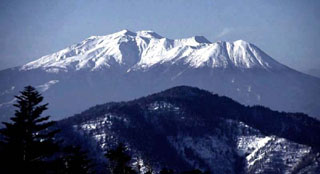Report on Ontakesan (Japan) — November 1992
Bulletin of the Global Volcanism Network, vol. 17, no. 11 (November 1992)
Managing Editor: Lindsay McClelland.
Ontakesan (Japan) Earthquake swarm but no change in gas emission
Please cite this report as:
Global Volcanism Program, 1992. Report on Ontakesan (Japan) (McClelland, L., ed.). Bulletin of the Global Volcanism Network, 17:11. Smithsonian Institution. https://doi.org/10.5479/si.GVP.BGVN199211-283040
Ontakesan
Japan
35.893°N, 137.48°E; summit elev. 3067 m
All times are local (unless otherwise noted)
A swarm of 40 small, shallow earthquakes, centered beneath the summit, were recorded between 1600 and 2000 on 12 November by a seismometer 2 km SE of the summit (figure 11). No change was recorded in the emission of steam, which has steadily risen to several tens of meters, and no volcanic tremor was recorded. This was the first increase in summit seismic activity since May 1991 when seismicity was accompanied by increased steaming and perhaps by minor ash ejection (Kazan, 1991).
Reference. Volcanic Activity in Japan during April-June 1991, 1991: Kazan, v. 36, no. 3, p. 385.
Geological Summary. The massive Ontakesan stratovolcano, the second highest volcano in Japan, lies at the southern end of the Northern Japan Alps. Ascending this volcano is one of the major objects of religious pilgrimage in central Japan. It is constructed within a largely buried 4 x 5 km caldera and occupies the southern end of the Norikura volcanic zone, which extends northward to Yakedake volcano. The older volcanic complex consisted of at least four major stratovolcanoes constructed from about 680,000 to about 420,000 years ago, after which Ontakesan was inactive for more than 300,000 years. The broad, elongated summit of the younger edifice is cut by a series of small explosion craters along a NNE-trending line. Several phreatic eruptions post-date the roughly 7300-year-old Akahoya tephra from Kikai caldera. The first historical eruption took place in 1979 from fissures near the summit. A non-eruptive landslide in 1984 produced a debris avalanche and lahar that swept down valleys south and east of the volcano. Very minor phreatic activity caused a dusting of ash near the summit in 1991 and 2007. A significant phreatic explosion in September 2014, when a large number of hikers were at or near the summit, resulted in many fatalities.
Information Contacts: JMA.


